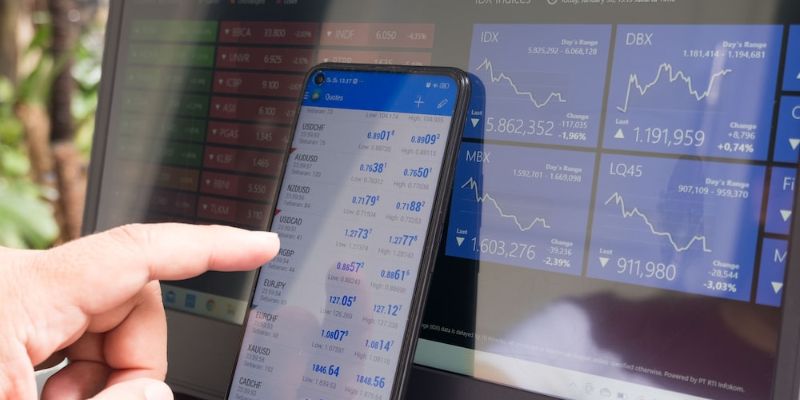How to Benefit from Price Action Trading Strategies?
Aug 02, 2023 By John Davis
Are you a trader looking for an effective and profitable strategy to take your investing experience to the next level? Price action trading strategies could be the perfect pathway for you to explore as they are easy to use profitable, and require minimal analysis of external factors.
In today's blog post, we will explore how price action strategies work, the advantages of using these strategies in comparison with more traditional technical analysis methods, and some important insights from successful traders on how they have benefitted from price action trading. Keep reading this full blog post to find out why implementing price actions into your portfolio is what your trading business needs.
Defining Price Action Trading Strategy

Price action trading is a technical analysis approach that relies exclusively on the price movements of a given security, such as stocks, futures contracts, forex currency pairs, or cryptocurrencies.
This strategy eliminates the need for complicated indicators and focuses instead on using various price patterns to decide whether to buy or sell a given asset. These price patterns can be identified by studying the historical data of the asset and observing how the market behaves in a given situation.
By utilizing price action strategies, traders can make informed decisions about when to enter or exit positions without relying too heavily on external factors such as news reports or analyst opinions. Furthermore, price action trading allows traders to react quickly to sudden market changes, which is extremely beneficial for those who want to take advantage of short-term opportunities.
Top Price Action Trading Strategies

One of the biggest advantages of price action strategies is that they are relatively easy to learn and apply, even for inexperienced traders. As long as you have a good understanding of market dynamics and can spot potential patterns in the chart data, it's possible to make profitable trades with price action strategies.
Some of the most popular price action strategies include:
Support and resistance trading
Support and resistance trading is a technique for finding potential entry and exit points in the market. This strategy looks for areas where price will likely find support (buying pressure) or resistance (selling pressure). By recognizing these levels, traders can decide when to enter and exit positions.
Trend following
Trend following involves identifying current market trends and taking positions accordingly. It is important to note that trend following works best when there is strong momentum in the market, as this will make it easier to spot potential entry and exit points.
To identify trends, traders will look at price action over a certain period and observe how the market behaves. Many traders also use technical indicators to help them detect changes in trend direction. It's important to remember that trends can change quickly, so it is essential to be prepared for sudden reversals.
Breakout trading
Breakout trading is a strategy used to capitalize on sudden changes in the market. Traders who use this technique look for levels where prices may break out and take positions accordingly. The idea is to catch a breakout before the price moves too far away from its entry point and make a profit.
Candlestick patterns
Candlestick patterns are a popular form of price action trading. This strategy looks for specific patterns such as pin bars, do jis, and engulfing candles that indicate potential opportunities in the market. The idea is to identify and take advantage of these patterns by entering into trades.
By recognizing the importance of market sentiment, traders can gain an edge over other participants unaware of these signals. Candlestick patterns are a great way to spot potential entry and exit points in the market, and they can be extremely useful for both short-term and long-term traders.
Price action reversals
Price action reversals involve identifying when prices are likely to reverse directions and acting accordingly. The idea is to take advantage of sudden changes in the market direction and profit before the prices move too far away from their entry points.
Momentum trading
Momentum trading is another popular price action strategy. This technique looks for strong movements in the market and takes positions accordingly. It is important to note that momentum trading works best when there is high volume in the market, as this will make it easier to spot potential entry and exit points.
Range trading
Range trading is a strategy used to take advantage of sideways markets. This technique looks for price levels where the market may find support or resistance and takes positions accordingly. By recognizing these levels, traders can capitalize on sudden shifts in market direction.
Swing trading
Swing trading is a popular price action strategy that involves taking positions based on periodic movements in the market. This technique looks for short-term price fluctuations and takes positions accordingly. Swing traders are looking to capitalize on sudden changes in the market direction, so monitoring the markets closely is important when using this technique.
Advantages of Price Action Trading Strategy
Price action strategies come with various advantages over more traditional technical analysis methods.
Here are some of the top benefits of using price action trading:
Learning and using
action strategies are relatively straightforward to understand, even for traders without experience.
No need for complicated indicators
This strategy eliminates the need for complex indicators, which can be difficult to interpret and decide from.
Quick reaction time
Price action strategies allow traders to react quickly to sudden market changes, which is extremely beneficial for those who want to take advantage of short-term opportunities.
Increased profits potentials
By relying solely on price patterns, you can get an edge in the market and increase your profit potential.
Low-risk trading
The nature of price action strategies allows traders to remain in control at all times. This means that it is possible to limit losses and manage risk effectively.
Increased confidence
By using a tried-and-tested price action strategy, traders can feel more confident in making profitable trades. This can help traders stay in the game for the long term.
Increased flexibility
Price action trading allows traders to adapt their strategies to different market conditions, which helps them stay one step ahead of the competition.
Price action trading is a great way to gain an edge in the markets and potentially increase your profits. However, it’s important to understand that this strategy does not guarantee success, and losing money is possible even with the best price action techniques.
As with any trading strategy, it’s important to understand the risks and develop a sound risk management system. With experience and dedication, price action strategies can be extremely useful for becoming a successful trader.
FAQS
Can you make money with price action trading?
Yes, it is possible to make money with price action trading. However, it’s important to understand that this strategy does not guarantee success, and risks are still involved.
Do professional traders use price action?
Yes, many professional traders use price action strategies to help them make profitable trades. This technique can be especially useful for traders who want to capitalize on short-term market opportunities.
What is the best time frame for price action trading?
The best time frame for price action trading depends on the individual trader’s goals and risk tolerance. However, most traders tend to focus on short-term strategies that look for market opportunities within 1-15 minutes.
Conclusion
Price action trading strategies can help traders identify and capitalize on market opportunities, manage risk, and make informed decisions. By combining technical analysis with fundamental analysis, traders can better understand the markets to maximize their profits and minimize their losses. With patience, practice, and the right mindset, you can become proficient in price action trading and improve your trading results.








